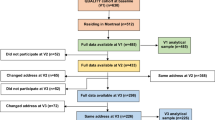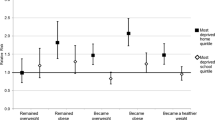Abstract
Background/Objectives:
To understand determinants of overweight, several studies addressed the association between neighbourhood characteristics and adult obesity. However, little is known about the association of such characteristics with adolescents’ overweight. This study aims at the influence of neighbourhood characteristics on adolescent body mass index (BMI) and lifestyle and to what extent BMI and lifestyle variation between neighbourhoods can be explained by neighbourhood characteristics.
Subjects/Methods:
We used cross-sectional data from the Kiel Obesity Prevention Study collected between 2004 and 2008 in 28 different residential districts of the city of Kiel (North Germany). Anthropometric data were available for 1675 boys and 1765 girls (n=3440) aged 13–15 years, and individual lifestyle factors and sociodemographic data were included in the analysis. At the macro level, six different neighbourhood characteristics were used: unemployment rate, population density, traffic density, prevalence of energy-dense food supply, number of sports fields and parks, and crime rate. To test our main hypothesis, linear and logistic multilevel regression analyses were performed to predict BMI and lifestyle factors in individuals nested in neighbourhoods.
Results:
Findings of multilevel analysis show little between-neighbourhood variations in BMI and health-related behaviours. In all, 2% of BMI variation, 4% of media time variation and 3% of variation in snacking behaviour could be attributed to differences in neighbourhoods.
Conclusions:
Environmental factors are significantly associated with adolescent BMI and health-related behaviour; however, their total effect is small. Owing to these results, recommendations for structural policy measures as part of prevention of overweight in adolescents must be made cautiously.
This is a preview of subscription content, access via your institution
Access options
Subscribe to this journal
Receive 12 print issues and online access
$259.00 per year
only $21.58 per issue
Buy this article
- Purchase on Springer Link
- Instant access to full article PDF
Prices may be subject to local taxes which are calculated during checkout

Similar content being viewed by others
References
Black JL, Macinko J (2008). Neighborhoods and obesity. Nutr Rev 66, 2–20.
Crawford DA, Timperio AF, Salmon JA, Baur L, Giles-Corti B, Roberts RJ et al. (2008). Neighbourhood fast food outlets and obesity in children and adults: the CLAN Study. Int J Pediatr Obes 3, 249–256.
Cummins SC, McKay L, MacIntyre S (2005). McDonald's restaurants and neighborhood deprivation in Scotland and England. Am J Prev Med 29, 308–310.
Danielzik S, Czerwinski-Mast M, Langnäse K, Dilba B, Müller MJ (2004). Parental overweight, socioeconomic status and high birth weight are the major determinants of overweight and obesity in 5-7 y-old children: baseline data of the Kiel Obesity Prevention Study (KOPS). Int J Obes Relat Metab Disord 28, 1494–1502.
Danielzik S, Pust S, Landsberg B, Müller MJ (2005). First lessons from the Kiel Obesity Prevention Study (KOPS). Int J Obes 29 (Suppl 2), S78–S83.
Davis B, Carpenter C (2009). Proximity of fast-food restaurants to schools and adolescent obesity. Am J Public Health 99, 505–510.
Duke PM, Litt IF, Gross RT (1980). Adolescents’ self-assessment of sexual maturation. Pediatrics 66, 918–920.
Elinder LS, Jansson M (2009). Obesogenic environments—aspects on measurement and indicators. Public Health Nutr 12, 307–315.
Ellaway A, Macintyre S, Bonnefoy X (2005). Graffiti, greenery, and obesity in adults: secondary analysis of European cross sectional survey. BMJ 331, 611–612.
Estabrooks PA, Lee RE, Gyurcsik NC (2003). Resources for physical activity participation: does availability and accessibility differ by neighborhood socioeconomic status? Ann Behav Med 25, 100–104.
Frank LD, Andresen MA, Schmid TL (2004). Obesity relationships with community design, physical activity, and time spent in cars. Am J Prev Med 27, 87–96.
Grund A, Krause H, Siewers M, Rieckert H, Müller MJ (2001). Is TV viewing an index of physical activity and fitness in overweight and normal weight children? Public Health Nutr 4, 1245–1251.
Harrington DW, Elliott SJ (2009). Weighing the importance of neighbourhood: a multilevel exploration of the determinants of overweight and obesity. Soc Sci Med 68, 593–600.
Kromeyer-Hauschild K, Wabitsch M, Kunze D, Geller F, Geiß H, Hesse V et al. (2001). Perzentile für den Body-mass-Index für das Kindes- und Jugendalter unter Heranziehung verschiedener deutscher Stichproben. Monatsschrift Kinderheilkunde 149, 807–818.
Kurth B-M, Schaffrath Rosario A (2007). Die Verbreitung von Übergewicht und Adipositas bei Kindern und Jugendlichen in Deutschland. Bundesgesundheitsblatt Gesundheitsforschung Gesundheitsschutz 50, 736–743.
Landsberg B, Plachta-Danielzik S, Much D, Johannsen M, Lange D, Müller MJ (2008). Associations between active commuting to school, fat mass and lifestyle factors in adolescents: the Kiel Obesity Prevention Study (KOPS). Eur J Clin Nutr 62, 739–747.
Lange D (2009). Influence of Social Characteristics and the Built Environment on Weight Status and Lifestyle Factors of Children and Adolescents of the Kiel Obesity Prevention Study (KOPS). Der Andere Verlag: Tönning.
Langnäse K, Mast M, Müller MJ (2002). Social class differences in overweight of prepubertal children in northwest Germany. Int J Obes Relat Metab Disord 26, 566–572.
Lobstein T, Baur L, Uauy R (2004). Obesity in children and young people: a crisis in public health. Obes Rev 5 (Suppl 1), 4–104.
Macdonald L, Cummins S, Macintyre S (2007). Neighbourhood fast food environment and area deprivation-substitution or concentration? Appetite 49, 251–254.
Mast M, Körtzinger I, Müller M (1998). Nutrition behaviour and status of children in Kiel aged 5 to 7 years. Akt Ernähr Med 23, 1–6.
Müller MJ, Mast M, Asbeck I, Langnäse K, Grund A (2001). Prevention of obesity—is it possible? Obes Rev 2, 15–28.
Plachta-Danielzik S, Landsberg B, Johannsen M, Lange D, Muller MJ (2010). Determinants of the prevalence and incidence of overweight in children and adolescents. Public Health Nutr 13, 1870–1881.
Rabe-Hesketh S, Skrondal A (eds) (2005). Multilevel and Longitudinal Modeling using Stata. Stata Press, College Station: Texas.
Rundle A, Roux AV, Free LM, Miller D, Neckerman KM, Weiss CC (2007). The urban built environment and obesity in New York City: a multilevel analysis. Am J Health Promot 21, 326–334.
Santana P, Santos R, Nogueira H (2009). The link between local environment and obesity: a multilevel analysis in the Lisbon Metropolitan Area, Portugal. Soc Sci Med 68, 601–609.
Smith KR, Brown BB, Yamada I, Kowaleski-Jones L, Zick CD, Fan JX (2008). Walkability and body mass index density, design, and new diversity measures. Am J Prev Med 35, 237–244.
Snijders T, Bosker R (1994). Modeled variance in two-level models. Sociol Methods Res 22, 342–363.
Stafford M, Cummins S, Ellaway A, Sacker A, Wiggins RD, Macintyre S (2007). Pathways to obesity: identifying local, modifiable determinants of physical activity and diet. Soc Sci Med 65, 1882–1897.
Story M, Neumark-Sztainer D, French S (2002). Individual and environmental influences on adolescent eating behaviors. J Am Diet Assoc 102, S40–S51.
Tanner J (1962). Growth at Adolescence. Blackwell Scientific Publication: Oxford.
World Health Organisation (WHO) (2006). WHO European Ministerial Conference on Counteracting Obesity. European Charter on Counteracting Obesity. Available at: http://www.euro.who.int/__data/assets/pdf_file/0009/87462/E89567.pdf. Accessed 16 March 2011.
Acknowledgements
This work was supported by the ‘Kompetenznetz Adipositas (Competence Network on Obesity)’ funded by the Federal Ministry of Education and Research (FKZ: 01GI0821) and by grants from Deutsche Forschungsgemeinschaft (DFG-MU 714–5.1–5) and WCRF.
Author information
Authors and Affiliations
Corresponding author
Ethics declarations
Competing interests
The authors declare no conflict of interest.
Rights and permissions
About this article
Cite this article
Lange, D., Wahrendorf, M., Siegrist, J. et al. Associations between neighbourhood characteristics, body mass index and health-related behaviours of adolescents in the Kiel Obesity Prevention Study: a multilevel analysis. Eur J Clin Nutr 65, 711–719 (2011). https://doi.org/10.1038/ejcn.2011.21
Received:
Revised:
Accepted:
Published:
Issue Date:
DOI: https://doi.org/10.1038/ejcn.2011.21
Keywords
This article is cited by
-
Risk Factors and Implications of Childhood Obesity
Current Obesity Reports (2018)
-
Pathways through which higher neighborhood crime is longitudinally associated with greater body mass index
International Journal of Behavioral Nutrition and Physical Activity (2017)
-
Childhood overweight in Berlin: intra-urban differences and underlying influencing factors
International Journal of Health Geographics (2016)
-
Neighbourhood socioeconomic context, individual socioeconomic position, and overweight in young children: a multilevel study in a large German city
BMC Obesity (2016)
-
Racial differences in the built environment—body mass index relationship? A geospatial analysis of adolescents in urban neighborhoods
International Journal of Health Geographics (2012)



